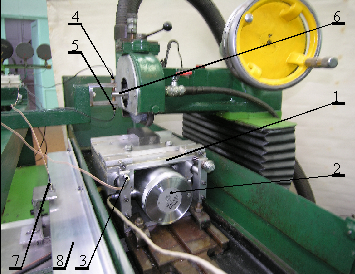Nowadays, the theoretical and experimental investigation of the influence workpiece surface waviness and roughness by forced vibration with different parameters introduced into grinder machine is being carried out. Results of this work will contribute to the developing an innovative technology of the vibratory grinding which gives the possibility of the grinding process and ground surface quality improvement. This method consists of introducing of the external forced vibration with specified frequency modulation and amplitude tangential to workpiece surface along the feed direction. In the case of surface grinding the vibration was introduced on workpiece by vibratory table with electrodynamical exciter. This process was applied for grinding with circumferential surface of grinding wheel which is realized with in-feed of the whole width of the grinding wheel into workpiece while the workpiece realizes longitudinal feed. Vibratory grinding of the cylindrical surface is realized by means of introducing the appropriate time-domain characteristics of the rotational speed of the workpiece which allows obtaining the desirable waviness of the ground shaft surface. The harmonic excitation parameters applied for ground surface geometry improvement are optimized in the process of modal analysis of the whole grinder’s construction.
The range of performed investigation comprises the theoretical analysis therein an elaboration of the physical model of the grinder, mathematical description of it and computer simulations of its dynamical behavior. Numerical solution of the system of differential equations describing the dynamics of the traditional and vibratory grinding process in the machine-tool – holder – workpiece – tool system of the surface grinder was obtained with the aid of the simulation package SIMULINK of MATLAB program. Numerical investigations have required an identification of the parameters being present in the physical model. Majority of those parameters were identified experimentally and the rest – analytically. Theoretical analysis has shown a damping influence of the forced vibration on an amplitude of the grinding wheel and workpiece relative displacement. This corresponds indirectly to the surface waviness.
Experimental investigation of the traditional and the vibratory grinding with and without the sparking out was carried out next. An influence of the forced vibration introduced into a grinding process on the state of workpiece surface layer have been determined by the measure of the surface roughness Ra parameter (average arithmetic deviation of roughness profile) as well as the surface waviness Wt (total height of waviness profile) and Wc5 (average height of the elements of waviness profile) parameters. The profilograms of ground surfaces were made after each series of experimental grinding tests. Vibratory grinding spark out process with the forced vibrations of amplitude of 10µm and frequency of 150Hz decreases a surface waviness.
Application of an innovative technology of the vibratory grinding can be utilized in order to decrease a workpiece surface waviness and roughness. It can find a practical application in abrasive machining of the hard ground materials and ceramics, by means of the cheaper and less rigid grinders and in the new technological processes of surface and cylindrical finishing.
Fig. Experimental stand with the vibratory table and mounted inductive sensors: 1 – vibratory table, 2 – electrodynamical exciter, 3 – inductive sensor for vibratory table displacement measurement, 4, 5 – inductive sensors in the differential system for spindle displacement measurement, 6 – gauge plunger, 7 – inductive sensor for main table displacement measurement, 8 – angle plate mounted into the main table
Reference:
- Oryński F., Bechciński G.: Doświadczalne badania procesu szlifowania wibracyjnego płaszczyzn. XXVI Naukowa Szkoła Obróbki Ściernej, Spała 2003, s. 323 ÷ 330.
- Bechciński G.: Aktywne oddziaływanie poprzez drgania na zmniejszenie falistości szlifowanych powierzchni płaskich. Praca Doktorska, Politechnika Łódzka, 2006.
- Witold Pawłowski: „Wibracyjne szlifowanie wgłębne wałków”, rozprawa habilitacyjna, Zeszyty Naukowe Politechniki Łódzkiej Nr 1068, Rozprawy Naukowe, Z. 393, Łódź, 2010
- Pawłowski W., Oryński F., Bojanowski S., 2011: „Dynamiczne właściwości modalne zespołu wrzeciennika ściernicy szlifierki kłowej z łożyskami i prowadnicami hydrostatycznymi”, Hydraulika i Pneumatyka, nr 5/2011, s.19÷22.
- Pawłowski W., Bojanowski S., 2011: „Teoretyczna analiza modalna zespołu wrzeciennika przedmiotu szlifierki do otworów”, Mechanik, Nr 11/2011, s.870-876.
- Pawłowski W., 2013: „Dynamic Model of Oscillation-Assisted Cylindrical Plunge Grinding With Chatter”, Journal of Manufacturing Science and Engineering, 135(5):051010-051010-6, doi:10.1115/1.4024819.
Key words: forced vibration, simulation, physical model, grinding, waviness, roughness

